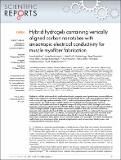| dc.contributor.author | Ahadian, Samad | |
| dc.contributor.author | Ramon-Azcon, Javier | |
| dc.contributor.author | Estili, Mehdi | |
| dc.contributor.author | Liang, Xiaobin | |
| dc.contributor.author | Ostrovidov, Serge | |
| dc.contributor.author | Shiku, Hitoshi | |
| dc.contributor.author | Ramalingam, Murugan | |
| dc.contributor.author | Nakajima, Ken | |
| dc.contributor.author | Sakka, Yoshio | |
| dc.contributor.author | Bae, Hojae | |
| dc.contributor.author | Matsue, Tomokazu | |
| dc.contributor.author | Khademhosseini, Ali | |
| dc.date.accessioned | 2014-07-08T19:33:42Z | |
| dc.date.available | 2014-07-08T19:33:42Z | |
| dc.date.issued | 2014-03 | |
| dc.date.submitted | 2013-09 | |
| dc.identifier.issn | 2045-2322 | |
| dc.identifier.uri | http://hdl.handle.net/1721.1/88211 | |
| dc.description.abstract | Biological scaffolds with tunable electrical and mechanical properties are of great interest in many different fields, such as regenerative medicine, biorobotics, and biosensing. In this study, dielectrophoresis (DEP) was used to vertically align carbon nanotubes (CNTs) within methacrylated gelatin (GelMA) hydrogels in a robust, simple, and rapid manner. GelMA-aligned CNT hydrogels showed anisotropic electrical conductivity and superior mechanical properties compared with pristine GelMA hydrogels and GelMA hydrogels containing randomly distributed CNTs. Skeletal muscle cells grown on vertically aligned CNTs in GelMA hydrogels yielded a higher number of functional myofibers than cells that were cultured on hydrogels with randomly distributed CNTs and horizontally aligned CNTs, as confirmed by the expression of myogenic genes and proteins. In addition, the myogenic gene and protein expression increased more profoundly after applying electrical stimulation along the direction of the aligned CNTs due to the anisotropic conductivity of the hybrid GelMA-vertically aligned CNT hydrogels. We believe that platform could attract great attention in other biomedical applications, such as biosensing, bioelectronics, and creating functional biomedical devices. | en_US |
| dc.language.iso | en_US | |
| dc.publisher | Nature Publishing Group | en_US |
| dc.relation.isversionof | http://dx.doi.org/10.1038/srep04271 | en_US |
| dc.rights | Creative Commons Attribution-Noncommercial-Share Alike | en_US |
| dc.rights.uri | http://creativecommons.org/licenses/by-nc-sa/3.0 | en_US |
| dc.source | Nature Publishing Group | en_US |
| dc.title | Hybrid hydrogels containing vertically aligned carbon nanotubes with anisotropic electrical conductivity for muscle myofiber fabrication | en_US |
| dc.type | Article | en_US |
| dc.identifier.citation | Ahadian, Samad, Javier Ramon-Azcon, Mehdi Estili, Xiaobin Liang, Serge Ostrovidov, Hitoshi Shiku, Murugan Ramalingam, et al. “Hybrid Hydrogels Containing Vertically Aligned Carbon Nanotubes with Anisotropic Electrical Conductivity for Muscle Myofiber Fabrication.” Sci. Rep. 4 (March 19, 2014). | en_US |
| dc.contributor.department | Harvard University--MIT Division of Health Sciences and Technology | en_US |
| dc.contributor.mitauthor | Khademhosseini, Ali | en_US |
| dc.relation.journal | Scientific Reports | en_US |
| dc.eprint.version | Final published version | en_US |
| dc.type.uri | http://purl.org/eprint/type/JournalArticle | en_US |
| eprint.status | http://purl.org/eprint/status/PeerReviewed | en_US |
| dspace.orderedauthors | Ahadian, Samad; Ramon-Azcon, Javier; Estili, Mehdi; Liang, Xiaobin; Ostrovidov, Serge; Shiku, Hitoshi; Ramalingam, Murugan; Nakajima, Ken; Sakka, Yoshio; Bae, Hojae; Matsue, Tomokazu; Khademhosseini, Ali | en_US |
| mit.license | PUBLISHER_CC | en_US |
| mit.metadata.status | Complete | |
